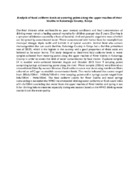| dc.contributor.author | Kindiki, Sarah | |
| dc.contributor.author | Wekesa, Clabe | |
| dc.contributor.author | Sifuna, Anthony | |
| dc.contributor.author | Siamba, Donald | |
| dc.contributor.author | Kollenberg, Mario | |
| dc.date.accessioned | 2019-04-03T08:09:48Z | |
| dc.date.available | 2019-04-03T08:09:48Z | |
| dc.date.issued | 2018-06-12 | |
| dc.identifier.isbn | 978-9966-59-011-5 | |
| dc.identifier.uri | http://erepository.kibu.ac.ke/handle/123456789/607 | |
| dc.description.abstract | Diarrheal diseases often attributable to poor sanitary conditions and fecal contamination of drinking water remain a leading cause of mortality for children younger than 5 years. Diarrhea is a symptom of infection caused by a host of bacterial, viral and parasitic organisms most of which can be spread by contaminated water. Water contaminated with human feces for example from municipal sewage, septic tanks and latrines is of special concern. Animal feces also contain microorganisms that can cause diarrhea. Kakamega County in Kenya has a diarrhea prevalence rate of 20.2%, which is the highest in the country and a good proportion of these cases are believed to be water borne. This study designed to determine fecal coliform levels in water samples collected from watering points along the upper reaches of River Isiukhu in Kakamega County in order to assess the level of water contamination by fecal matter. Duplicate samples, 54 in number were collected between August and October 2015 from 9 sampling points comprising springs and watering points along the river. Water samples (100ml) were filtered on nitrocellulose filters by vacuum filtration. Fecal coliform count was done using membrane filters cultured on mFC agar to establish contamination levels. The results indicated that counts ranged from 200cfu/100ml - 1450cfu/100ml in river sampling points and in springs counts ranged from 0cfu/100ml - 44cfu/100ml. The fecal coliform counts for River Isiukhu and most springs surrounding it exceeded the WHO recommended drinking water coliforms or E.coli count value of 0 cfu/100ml concluding that water from the upper reaches of River Isiukhu and spring is not fit for drinking before treatment especially during wet seasons based on the WHO drinking water standard and the water quality. | en_US |
| dc.language.iso | en | en_US |
| dc.publisher | KIBU | en_US |
| dc.rights | Attribution-NonCommercial-ShareAlike 3.0 United States | * |
| dc.rights.uri | http://creativecommons.org/licenses/by-nc-sa/3.0/us/ | * |
| dc.subject | Fecal-coliform | en_US |
| dc.subject | Contamination | en_US |
| dc.subject | River -water | en_US |
| dc.subject | Spring-water | en_US |
| dc.subject | Season | en_US |
| dc.title | Analysis of fecal coliform levels at watering points along the upper reaches of river Isiukhu in Kakamega County, Kenya | en_US |
| dc.type | Working Paper | en_US |

